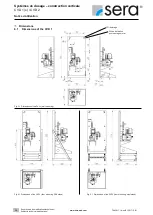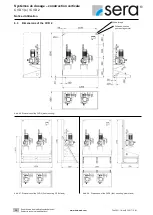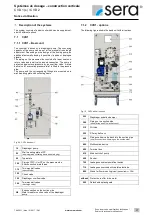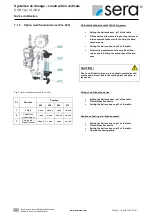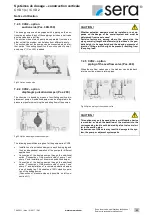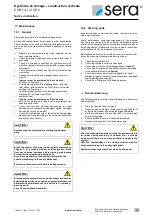
Systèmes de dosage – construction verticale
CVD 1 (s) / CVD 2
Notice d’utilisation
48
Sous réserve de modifications techniques !
Subject to technical modifications!
www.sera-web.com
TA450-11 / fr/en /01.2017 / PM
8.4
Electrical connection
The electrical connection of the system is to be made depend-
ing on the system design (please see the product description
in the Appendix) and according to the wiring diagrams on the
data carrier supplied.
CAUTION !
The electrical connection must only be done by qualified
personnel! The local safety regulations must be observed!
CAUTION !
The fuse protection and the characteristics of the electri-
cal components are indicated in the separate manuals.
CAUTION !
Have the electrical installation checked by the responsible
safety officer after the work was finished. Carry out an in-
sulation measurement if necessary!
Commissioning
CAUTION !
Start the system only after it was released by the respon-
sible safety officer!
CAUTION !
In principle the system is started up with water.
CAUTION !
It is the owner’s task to ensure that the local regulations
for prevention of accidents are observed!
Carry out the following steps to start the system:
•
Before commissioning check all the pipe connections,
screwed and flanged connections etc. for proper fit and
retighten, if necessary.
•
Before switching on the system for the first time, the fol-
lowing points should be checked:
o
Check the electrical connections and the terminal
assignment.
o
Check the electrical excess-current cut-outs for
proper operation and correct setting.
o
Check whether the local supply voltage and fre-
quency correspond with the indications on the type
plates.
o
Check proper function of the leakage sensor
(option – must be evaluated by the customer)
by lifting the float switch
o
Check proper function of the leakage sensor sole-
noid float switch (without admission WHG)
(option – must be evaluated by the customer)
by lifting the float switch.
To check proper function of the leakage sensor plate
electrode EP (with admission WHG)
(option – must be evaluated by the customer)
see data sheet.
•
Carry out the first start-up with water. Pay attention to the
water quality according to Chapter 2.
•
Open all shut-off devices that are required for operation.
Close the shut-off devices for emptying the pipes.
•
Set the stroke adjustment and the stroke frequency ad-
justment (only for C-pumps) to values lower than 50%
and start the pumps slowly.
•
Preload the pulsation damper
(option)
to the pressure
required for operation according to the separate operating
instructions (see data carrier). This corresponds normally
to 50% of the operating pressure.
•
The overflow valves are factory set to the maximum ad-
missible operating pressure of the dosing pump(s) (see
product description).
CAUTION !
Check whether the set pressure of the overflow valves
must be reduced in relation to other system parts installed
which may only be submitted to a lower load.
Correct the settings according to the operating instruc-
tions “Diaphragm overflow valve” (TA 048, see data carri-
er enclosed).
•
Have the pump(s) deliver against operating pressure and
check the piping for leakage.
•
After start-up drain off the water completely from all the
pipes, tanks and pumps.
•
Start the dosing system with the chemical reagent.
CAUTION !
Note the compatibility of the chemical with water and take
appropriate measures, if necessary.
Pay attention to the safety data sheet of the medium.
Make sure that no exothermic reactions can occur which
may lead to personal injury or damage to the system.

